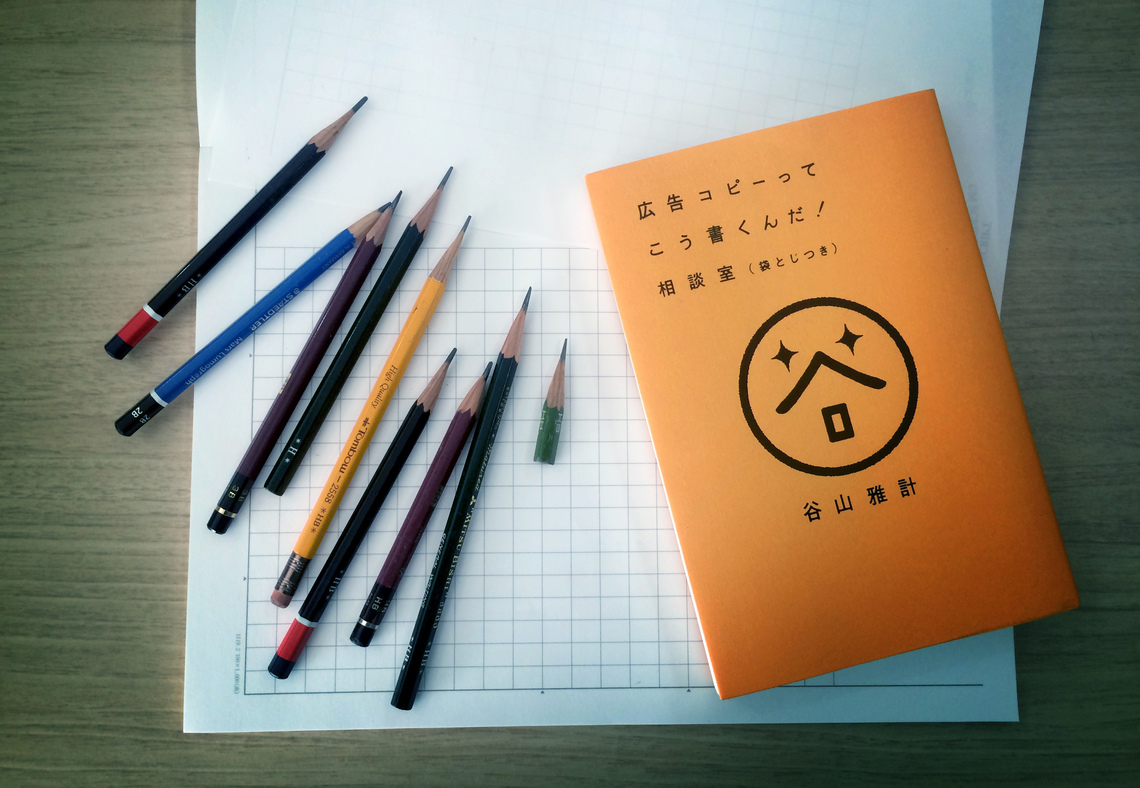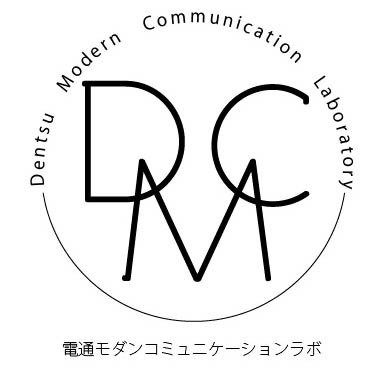Hello, I'm Miichi from Dentsu Inc.'s Creative Planning Division 2. A few years ago, I attended Masayoshi Taniyama's copywriting class hosted by the Advertising Conference. It was an excellent class, and what made it great? The instructors were truly sadistic. We were their prime customers—paying a decent fee, writing about 100 pieces of copy weekly, and attending lectures seriously. Yet, week after week, they just kept yelling at us (laughs).
"Your copy is completely useless! Let's discuss why it's no good in front of everyone!" Sometimes shouted loudly, sometimes delivered with cold precision... I attended every week trembling with fear. I exaggerated a bit for effect, but looking back, that's the impression I have. Yet that strictness was truly beneficial. Behind the harshness, I sensed an immense kind of love, and I firmly believe that having such high standards constantly set for me has become the foundation of my current work.
That was a bit of a long preamble, but the book I'm introducing today is Mr. Taniyama's new work, 'This Is How You Write Advertising Copy! Consultation Room (Includes Special Insert)' (Sendenkaigi). It's a valuable volume packed with questions about copywriting submitted to the "Grand Question Session" held in Mr. Taniyama's class, along with his incredibly precise answers. Now, let me share a few Q&A examples.
Q. I don't know how to choose from the copy I've written and scattered everywhere.
I know that feeling... the feeling of not knowing. The more copy you write, the more you lose objectivity, and it becomes hard to tell which copy is truly good. In response to this struggle, Mr. Tanigawa prefaced his answer by noting that advertising is teamwork, so having the professionals around you choose is also an option. He then shared a training method to develop your own selection skills.
Practice "living with the opposite perspective." When you're the audience, think with the creator's eyes. When you're the creator, think with the audience's eyes. Make this a complete habit in your daily life.
For example, as a consumer. Even when watching a movie, think from the creator's perspective: "How could this foreshadowing be used later to make it more interesting?" or "This character introduced here could play such a role later, couldn't they?" (P.40)
It's not about having some trick for choosing copy on the spot. It's about cultivating the muscle of objectivity (how things appear to others) in your daily life, which gradually enables you to select copy. This applies not just to copywriting, but also to improving planning and presentations, doesn't it? It seems obvious when you think about it, but hearing it phrased as a famous quote makes you pause. Living a life that constantly shifts between "creator mode" and "consumer mode" seems incredibly effective for people whose livelihood involves communication.
Q. How should I handle revision requests from clients that are way off target?
This is another common question, and Mr. Taniyama answers decisively: "Of course, we make the revisions." He adds that this is because he knows history is full of masterpieces born from unreasonable criticism.
Apparently, the title of Shigeru Mizuki's manga "GeGeGe no Kitaro" was born this way.
Originally, when it was published in a magazine, it was titled "Graveyard Kitaro." But when it was adapted into a TV anime, the sponsor complained, "We can't possibly fund something with such an unlucky title!"
So, they decided to change the title. But for the author, Mizuki, Kitaro was a ghost born in a graveyard, so it really had to be "Graveyard Kitaro." If he had insisted on that, the manga might never have become an anime, and it might not have become the popular, enduring work it is today. (P.81-82)
When unexpected criticism comes, and you take it head-on and manage to overcome it, the copy or ad surprisingly often ends up better than it was before the criticism. You know how sometimes after a presentation, a client says, "Okay, please brush this up in this direction," and you get annoyed? Like, "Brush it up? It's already perfect!" (laughs). But that's actually a crucial phase. It's a step where an idea, which might be highly polished from one person's perspective but somewhat closed off, gets hammered out based on feedback from various viewpoints. This process nurtures it into a more open, expansive expression that resonates with a wider audience.
Q. Could you share your approach to naming?
This book delves not just into copywriting, but thankfully also into the thinking behind naming. While there are countless how-to books on copywriting, many people approach naming without much systematic knowledge, just writing names based on a hunch. Mr. Taniyama presents one key starting point for considering naming:
Is the product something that "influences the character of the person who uses it," or is it something that "does not influence them"?
For example, suppose there is a person named Tanaka. Even if he routinely uses a "cockroach trap" at home, people around him wouldn't say, "Oh, you mean Mr. Tanaka who always uses that 'cockroach trap'?" (P112)
However, some products do influence the character of the person who owns or uses them.
For example, cars lead to descriptions like "Mr. Tanaka who drives a BMW" or "Mr. Tanaka who drives a Prius." (P113)
It's remarkably clear. For products that don't affect character, a straightforward, functional name that immediately conveys its purpose is better than overcomplicating the name. Conversely, for products that do influence character, it's better to prioritize sound over meaning, avoiding names that might make ownership seem embarrassing or lead to boredom. This approach seems useful as a starting point for naming, or as a clear guideline when discussing with clients whether "shouldn't the function be emphasized more in the product name??"
Q. How will the role of copywriting change with media diversification?
This book predicts that copywriting work "might be broadly divided into two categories." Today, you don't have to rely solely on copy; diverse media and technology can bring people right to the point of communication. In that case, the copywriter's job becomes crucial in crafting solid explanatory text and body copy that truly satisfies them further down the line. On the other hand, copywriters who articulate a company's mission or brand vision at the upstream stage will also become highly necessary.
If I may be so bold, I experience this daily. Lately, if you skillfully combine a core idea with the right media, you can get a two-base hit. However, to truly make that core idea powerful enough to hit a home run, the underlying brand vision must be essential. Without that foundation, campaigns inevitably feel superficial. Conversely, even with a strong core idea, if the quality of the smaller copy pieces at the sales frontline is low, the product won't move despite generating buzz. That happens too. I feel the power of words, both upstream and downstream, is becoming increasingly important.
"Bag Sealing" is a must-read for copywriters.
So far, I've shared the Q&A that personally resonated with me, but there are many other questions too. "What is copy, ultimately, in one word?" "Please teach me presentation tips." "What makes an ideal brief?" "What's the difference between people who thrive and those who don't?" You want answers to all of them, right...? (laughs). The way he logically addresses every single one, using plain language and clear, concrete examples, is truly refreshing.
Also, while this review didn't mention it, another major feature worth highlighting is the "sealed insert." At first glance, I thought, "This is kinda... sexy?" (laughs), but opening it was amazing. It reveals the notebook used when creating Tokyo Gas's famous copy "Gas-Pa-Cho!" almost exactly as it was written. Moreover, right beside it, the process is explained in incredible detail (!), including what the client said at the time and how that influenced the thinking. Alongside the "How to Write General Copy (Campaign Copy)" section at the book's end, this is essential reading for copywriters handling major campaigns or competitive pitches.
As the title "Consultation Room" suggests, it feels like you're actually there: Mr. Taniyama sits at the front of a class of about 30 students, patiently answering their questions. That's why it reads so smoothly, yet it's incredibly useful. It was such a wonderful book.






